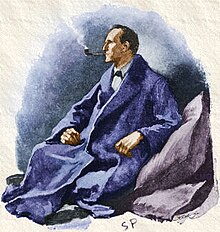Sherlock Holmes (/ˈʃɜːrlɒk ˈhoʊmz/ or /-ˈhoʊlmz/) is a fictional private detective created by British author Sir Arthur Conan Doyle. Referring to himself as a "consulting detective" in the stories, Holmes is known for his proficiency with observation, deduction, forensic science, and logical reasoning that borders on the fantastic, which he employs when investigating cases for a wide variety of clients, including Scotland Yard.
First appearing in print in 1887's A Study in Scarlet, the character's popularity became widespread with the first series of short stories in The Strand Magazine, beginning with "A Scandal in Bohemia" in 1891; additional tales appeared from then until 1927, eventually totalling four novels and 56 short stories. All but one are set in the Victorian or Edwardian eras, between about 1880 and 1914. Most are narrated by the character of Holmes's friend and biographer Dr. John H. Watson, who usually accompanies Holmes during his investigations and often shares quarters with him at the address of 221B Baker Street, London, where many of the stories begin.
Though not the first fictional detective, Sherlock Holmes is arguably the best known.[1] By the 1990s there were already over 25,000 stage adaptations, films, television productions and publications featuring the detective,[2] and Guinness World Records lists him as the most portrayed literary human character in film and television history.[3] Holmes's popularity and fame are such that many have believed him to be not a fictional character but a real individual;[4][5] numerous literary and fan societies have been founded on this pretense. Avid readers of the Holmes stories helped create the modern practice of fandom.[6] The character and stories have had a profound and lasting effect on mystery writing and popular culture as a whole, with the original tales as well as thousands written by authors other than Conan Doyle being adapted into stage and radio plays, television, films, video games, and other media for over one hundred years.
Personality and habits
Watson describes Holmes as "bohemian" in his habits and lifestyle.[50] Said to have a "cat-like" love of personal cleanliness,[51] at the same time Holmes is an eccentric with no regard for contemporary standards of tidiness or good order. Watson describes him as
While Holmes can be dispassionate and cold, during an investigation he is animated and excitable. He has a flair for showmanship, often keeping his methods and evidence hidden until the last possible moment so as to impress observers).[53] His companion condones the detective's willingness to bend the truth (or break the law) on behalf of a client—lying to the police, concealing evidence or breaking into houses—when he feels it morally justifiable.[54]
Except for that of Watson, Holmes avoids casual company. In "The Gloria Scott", he tells the doctor that during two years at college he made only one friend: "I was never a very sociable fellow, Watson ... I never mixed much with the men of my year".[55]
The detective goes without food at times of intense intellectual activity, believing that "the faculties become refined when you starve them."[56][57]
At times Holmes relaxes with music, either playing the violin,[58] or enjoying the works of composers such as Wagner[59] and Pablo de Sarasate.[60]
Drug use
Holmes occasionally uses addictive drugs, especially in the absence of stimulating cases.[61] He sometimes used morphine and sometimes cocaine, the latter of which he injects in a seven-percent solution; both drugs were legal in 19th-century England.[62][63][64] As a physician, Watson strongly disapproves of his friend's cocaine habit, describing it as the detective's only vice, and concerned about its effect on Holmes's mental health and intellect.[65][66] In "The Adventure of the Missing Three-Quarter", Watson says that although he has "weaned" Holmes from drugs, the detective remains an addict whose habit is "not dead, but merely sleeping".[67]
Watson and Holmes both use tobacco, smoking cigarettes, cigars, and pipes. Although his chronicler does not consider Holmes's smoking a vice per se, Watson—a physician—does criticise the detective for creating a "poisonous atmosphere" in their confined quarters.[68][69]








0 Comments